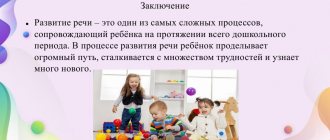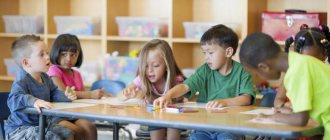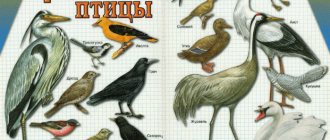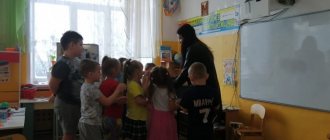Tasks and exercises to develop orientation
To form and develop a child’s spatial orientation, it is necessary to use special tasks and exercises. The level of difficulty should be appropriate for the age of the preschooler. Examples of games for children of primary preschool age:
Funny game “You are a part of me.” Goal: consolidate knowledge about body parts.
The adult throws the ball to the baby and says:
- I am the face. You are a part of me. Who are you? (eyes, eyebrow, nose...)
- I am the head. You are a part of me. Who are you? (hair, ears...)
- I am the torso. You are a part of me. Who are you? (tummy, back...)
Tasks to determine the position of objects in space:
- "Where does the bell ring?" The baby closes his eyes. The adult hides and rings the bell. The child opens his eyes and determines the adult’s location by sound.
- "Toy for a walk." Take your child's small toy. Place different objects (ball, box, jar, etc.) on the table or floor. Say that the toy wants to go for a walk and the baby should accompany it, while voicing the directions of movement: “forward - back”, “right-left”.
- “Who is where?” It is necessary to place toys in different places in the room. Ask your child where each toy is from him.
- “Where is the toy, tell me?” Four chairs stand in a circle, and on each of them sits a toy. A child sits on a chair in the center. The adult names the toy, and the baby must say where it is on the right, left, front, back. Then the toys change places.
- “Fruit mosaic.” An adult puts an orange, a tangerine, an apple on the table and invites the preschooler to take the orange in his right hand and the tangerine in his left. The following are the instructions: put the orange to the right of the apple, the tangerine to the left; arrange the fruit so that the tangerine is between the orange and the apple, etc.
Development of orientation in older preschoolers using diagrams
In children aged 6 to 7 years, the development of spatial concepts is expanded using the modeling method. This method can be used in different forms, but the most relevant are diagrams.
When figuring out how to get to the final point, a preschooler feels like a traveler, a treasure hunter or a rescuer. For example,
- "Find the treasure." There is a “treasure” (a box of treats) hidden in the room. The child is offered play motivation: “You are a traveler looking for treasure. The card shows a diagram that will help you find it. Hold the card in front of you, look in which direction the arrows are pointing, and follow them. Be careful".
- “Help Masha find her way home.” Instructions: “Draw Masha’s path on a piece of paper, starting from the arrow to the house shown: one cell up, two to the left, two up, one to the right, one down, one to the right, two up, etc.” This task is based on graphic dictation.
- Make a schematic plan of your room (kitchen, playroom in kindergarten, etc.), marking pieces of furniture with squares and circles.
Graphic labyrinths provide effective assistance in developing a child’s orientation and spatial thinking skills.
After the child has found the right path through the maze (in this picture you need to help the mouse get to the apple), it is important to invite him to describe the route with the words: “Walk straight along the path, turn left, step onto the next path and turn left again, etc. "
At the first stages, the help of an adult is necessary, since the preschooler must understand the algorithm for determining the route using a diagram or sketch of a plan. Subsequently, there is enough control when performing the task.
It should be noted that preschoolers are interested in learning spatial orientation. This is a natural need, and the child unconsciously feels that he is expanding his own boundaries when he understands more about the organization of space. All he needs is a little help from an adult.
Consistent formation of spatial orientation in preschool age
The formation of spatial orientation is several successive stages of a child’s acquisition of the necessary knowledge, skills and abilities.
- Self-orientation. The baby acquires knowledge about the location of parts of his own body.
- Orientation "from yourself". The child develops visual-motor coordination and distinguishes between the main groups of directions (forward-backward, up-down, right-left).
- Orientation “from the subject”. The ability to determine in words the position of one or another object in relation to another.
- The ability to navigate in three-dimensional space while moving.
- Ability to navigate on a plane (in two-dimensional space).
Each of the stages is another step, the ascent of which depends on the age of the baby and previously acquired knowledge.
Child's awareness of his own body
The formation of skills to navigate in space begins with ideas about one’s own body.
It is this knowledge that subsequently serves as the basis for understanding information about spatial landmarks. Therefore, by the age of 3, a child should show and name parts of the body and face.
At this age, children are led to understand that there is a right and a left hand. The baby is able to remember and show the right hand if he is asked about left or right. But he perceives these words as the name of a hand; the essence of the concept is not yet available to him.
Orientation "from yourself"
Having mastered the parts of his own body, the baby begins to use them as a guide. For example, a child learns that the position of the head is up and the legs are below. Accordingly, you can ask questions:
- “Look what’s up there?” (sun, tree branches, etc.);
- "What's down there?" (path, grass, etc.).
- Let's see what objects are located to your right.
Thus, the child’s own body is the main point of reference.
The child places objects in a new position and receives novelty of orientation signals. The ball just lay in front on the right. A small movement, and it already needs to be said that he is on the left or behind. For a child this is a real discovery.
Children 3-4 years old first learn only one concept in paired spatial notations: under, above, to the right, behind. Obviously, each of the listed words has its own pair. But the child’s awareness of “above”, “below”, etc. occurs later.
It is useful to teach a child to describe in words the position of objects in relation to him. For example, “The closet with toys in the back” or “The box with blocks in front of me.” You can play a game with your child: “Where is the window from you?” An adult asks the question: “Where is the window from you? (floor, chair, picture, etc.). The correct answers will not be given right away, but after several attempts and explanations from an adult, the child will increasingly answer correctly and consciously.
Orientation from a third-party reference point
Having moved to the next stage, the child begins to perceive another person or object as an object of orientation. At this time, it is necessary to reinforce the basic concepts of directions: left, right, forward, backward, up, down, behind, between, under, etc.
It is recommended to use pictures for this. When considering them, you need to ask questions: “Who is drawn in front of the fence?”, “Who is standing under the bridge?” or “What bird is flying over the tree? Which one is sitting on the tree? Which one is under the tree?”, “Who (what) is far away?”; “Who (what) is close?” etc. Similar questions can be asked, for example, while walking, taking any object or person as a guide.
It is especially difficult for preschoolers to determine the left and right sides (hands) of another person. Having firmly learned which hand is his right, the child is at a loss as to which hand is considered right for the people or dolls standing in front of him.
An experiment with a ribbon helps to understand such a difficult issue for a child. You need to place the doll with its back to the child, tie bright identical ribbons on the child’s right arm and on the same hand of the doll. Having discussed the placement of the marks with the child, turn the doll to face him and trace where the doll’s marked hand is.
It may be necessary to perform exercises of this kind several times with different toys before the preschooler develops an understanding of the orientation of the sides.





